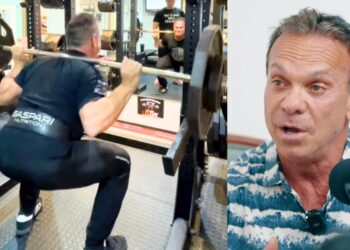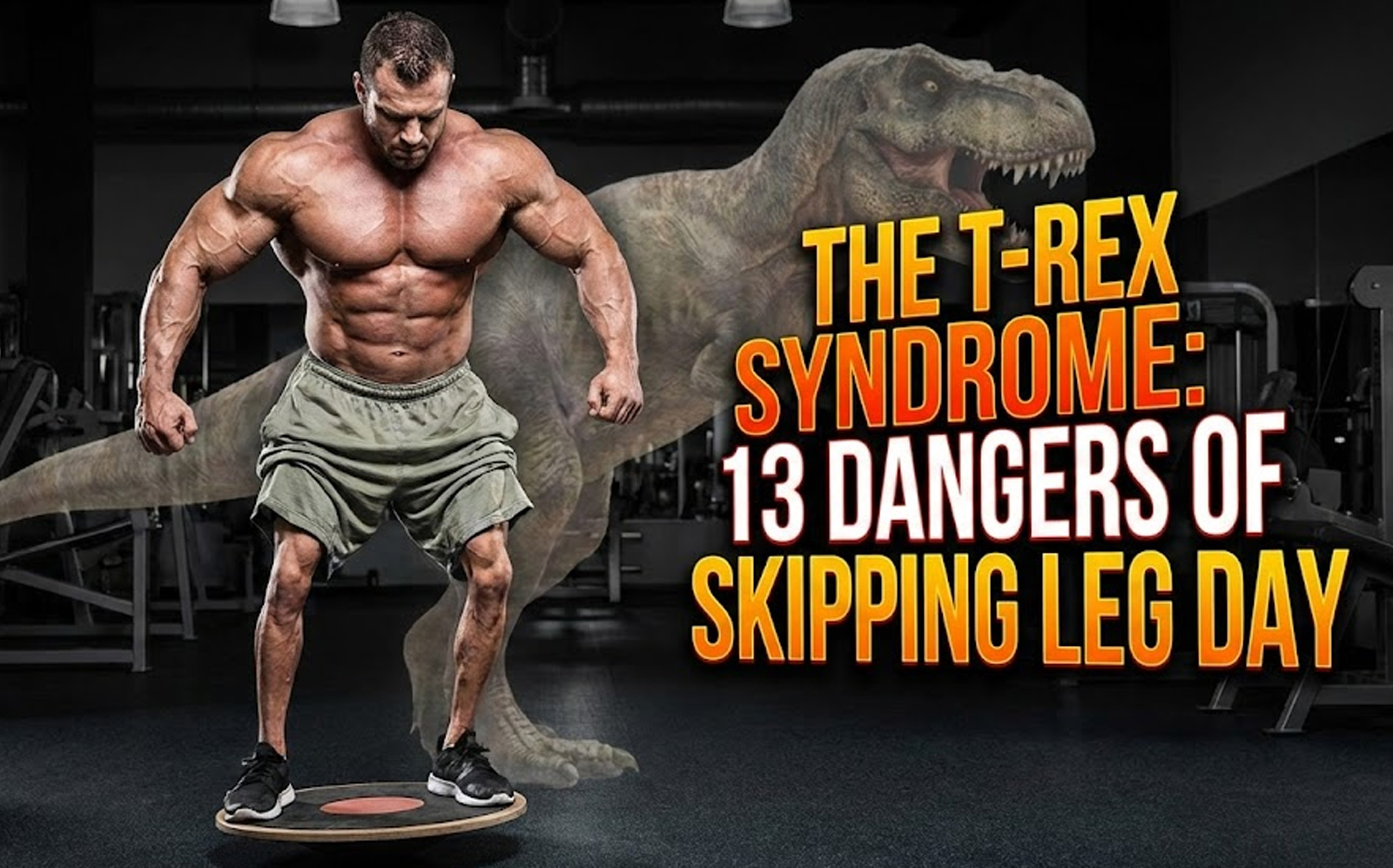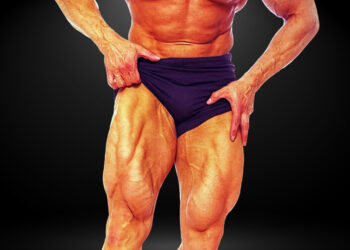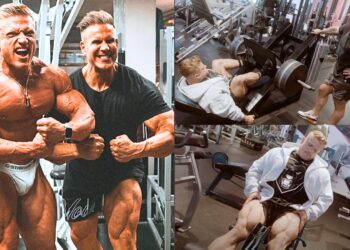Many trainers love to write complicated workout programs. And while these might work, they’re often beyond the reach of lifters who train at home or garage gyms or simply do not have access to state-of-the-art equipment.
The good news is that you don’t need to train in a million-dollar facility to achieve your fitness goals. In fact, all you need is a barbell, a squat rack, and plenty of weight plates.
You see, your muscles cannot really differentiate between doing barbell squats with a heavy barbell or leg presses on a $50,000 leg press machine. They just know tension and work.
Providing you train hard enough, your muscles will grow and adapt regardless of how you overload them. After all, old-school bodybuilders built incredible physiques with very basic equipment in what were often basically underground basements.
In this article, I’m taking a page from the golden era of bodybuilding and giving you a barbell-only leg workout to try. Don’t let its simplicity fool you; many of my personal training clients have achieved tremendous strength and muscle gains with this brutal workout.
Level Up Your Fitness: Join our 💪 strong community in Fitness Volt Newsletter. Get daily inspiration, expert-backed workouts, nutrition tips, the latest in strength sports, and the support you need to reach your goals. Subscribe for free! Recent Updates: On June 17, 2024, Fitness Volt’s Senior Editor, Vidur Saini (American Council on Exercise-CPT), updated the article and added actionable expert tips throughout the piece to improve the reader experience.
7 Best Leg Exercises
There are two ways to do any exercise: the right way and the wrong way.
The right way is easy on your joints, puts loads of tension on the target muscle, and produces the best results.
The wrong way is usually less effective and more likely to cause injury. So, make sure you do each exercise in this workout the right way by following these instructions:
- Bottoms-up front squat
- 1 ½ Romanian deadlift
- Barbell walking lunges
- Barbell hack squat
- Barbell hip thrust
- Barbell standing calf raise
- Barbell seated calf raise
1. Bottoms-up front squat
| Sets & Reps | Equipment Needed | Target Muscles |
| 3 x 8-12 | Barbell | Quadriceps, anterior core, shoulders, grip |
While the barbell back squat is often called the king of exercises, the front squat is arguably the better muscle builder. The range of motion is usually bigger, and the upright torso position makes it more quads-centric. On the downside, some lifters do find front squats more awkward.
This bottoms-up variation involves a brief pause between reps in the bottom position, making it somewhat more manageable.
“As you ascend from the bottom of the squat, consciously drive your elbows upwards,” says Saini. This cue will prevent the barbell from rolling down your shoulders.
How to do it:
- Set the safety bars on your squat or power rack to around hip height. You’ll need to experiment to find the perfect position. Rest your barbell on the safety bars.
- Stand behind the barbell. Squat down, so the bar is across the front of your shoulders. Hold it with a shoulder-width grip. Position your feet, so they’re about hip-width apart, toes pointing forward.
- Brace your abs. Make sure your lower back is slightly arched and not rounded.
- Drive your feet into the floor and stand up explosively.
- Descend under control and lower the barbell back to the safety pins.
- Allow the weight to settle for 1-2 seconds, reset your core, and repeat.
Pro Tip: Keep your core braced in the bottom position to generate maximal force during the lifting phase.
| Difficulty | Progression | Regression |
| Intermediate | Thrusters | Goblet squat |
2. One-and-a-Half Romanian deadlift
| Sets & Reps | Equipment Needed | Target Muscles |
| 3 x 6-10 | Barbell | Hamstrings, glutes, erector spinae (lower back) |
Romanian deadlifts are among the best glute, hamstring, and lower back exercises. But, as good as they are, they’ll soon start to lose their potency if you do them too often. Performing them with the 1 ½-rep method increases time under tension. This will provide the variety you need to ensure they’re always challenging and productive.
Saini opines that the extra 1/2 rep at the bottom of the movement creates a unique stimulus for hamstring hypertrophy. This is where the muscle is under the most tension, potentially leading to accelerated growth.
How to do it:
- Hold your barbell with a shoulder-width overhand grip. Use lifting straps if necessary. Stand with your feet roughly shoulder-width apart, knees slightly bent.
- Hinging from the hips and without rounding your lower back, lean forward and lower the barbell to around knee height.
- Drive your hips forward and stand back up.
- Next, hinge forward again, but this time lower the bar down to mid-shin height. Take care not to round your lower back.
- Stand back up to complete your rep.
- That’s one – keep going!
Pro Tip: Initiate the movement by pushing your hips back rather than bending at the knees. This emphasizes hamstring engagement, protects the lower back, and enhances power generation from the posterior chain.
| Difficulty | Progression | Regression |
| Intermediate | Deficit deadlifts | Conventional RDLs |
3. Barbell walking lunges
| Sets & Reps | Equipment Needed | Target Muscles |
| 3 x 10-15 (each leg) | Barbell | Quadriceps, hamstrings, glutes, core |
Many bodybuilders are very quick to dismiss lunges and label them ineffectual. However, this is wrong. Lunges are a great quad, glutes, and hamstring builder, and they were one of Ronnie Coleman’s favorite leg exercises.
Big Ron would do laps of the gym parking lot with as much as 225 pounds on his back, and his legs were massive! So, be like Coleman and respect walking lunges.
Beyond muscle building, walking lunges are a fantastic assessment tool, states Saini. If you struggle to maintain balance or a neutral spine, it’s a sign you need to address core strength and hip stability before loading heavier squats or deadlifts.
How to do it:
- Rack and hold your barbell across your upper back. Make sure it’s on your traps and NOT your neck. Brace your abs, stand with your feet together, and look straight ahead.
- Take a large step forward, bend your legs, and lower your rear knee to an inch above the floor.
- Step forward with your rear leg and into another rep.
- Continue alternating legs until you have covered the prescribed distance.
- No space for walking lunges? Do regular alternating barbell lunges instead.
Pro Tip: As you step forward into the lunge, consciously “screw” your front foot into the ground, rotating it slightly outward. This activates the glutes and stabilizes the knee joint, reducing stress and maximizing power transfer.
| Difficulty | Progression | Regression |
| Beginner | Increase distance, add weight to barbell | Bodyweight lunges |
4. Barbell hack squat
| Sets & Reps | Equipment Needed | Target Muscles |
| 3 x 8-12 | Barbell | Quadriceps |
Before the hack squat machine became popular, this is how people did hack squats. This exercise is named after Estonian weightlifter and wrestler George Hackenschmidt, who was famed for his huge thighs and immense strength (1).
Level Up Your Fitness: Join our 💪 strong community in Fitness Volt Newsletter. Get daily inspiration, expert-backed workouts, nutrition tips, the latest in strength sports, and the support you need to reach your goals. Subscribe for free!
Traditionally, barbell hack squats are done with elevated heels, which increases quad activation. However, some exercisers may find this puts too much stress on the knees. If you do lift your heels, start with a small block to see how your knees feel, not just during the exercise but afterward, too.
How to do it:
- Place your barbell on the floor. Depending on the diameter of the plates being used, you may need to place the bar on blocks to be able to reach it.
- With your back to the weight, stand with your feet about shoulder-width apart and the bar touching your calves.
- Squat down and grab the bar with your hands facing backward. Use lifting straps if necessary.
- Straighten your arms, make sure your back is slightly arched, pull your shoulders down and back, and brace your abs.
- Drive your feet into the floor and stand up, pulling the bar up the back of your legs as you ascend.
- Bend your legs and lower the weight back to the floor. Reset your core and grip and repeat.
Pro Tip: Experiment with foot placement to target different areas of the quadriceps. A wider stance emphasizes inner quad engagement, while a narrower stance biases the outer quad.
| Difficulty | Progression | Regression |
| Intermediate | Increase weight, slower tempo on the eccentric (lowering) | Leg press, goblet squat |
5. Barbell hip thrust
| Sets & Reps | Equipment Needed | Target Muscles |
| 3 x 8-12 | Barbell | Glutes, hamstrings |
Barbell hip thrusts are a lower-back-friendly way to train your glutes and hamstrings. While you can do this exercise with just your body weight for resistance, it’s much more effective if you rest and hold a barbell across your hips. Go heavy with this exercise — the glutes and hamstrings are pretty powerful and usually respond well to plenty of weight.
Don’t underestimate the carryover of hip thrusts to other exercises, says Saini. A strong glute bridge built here translates to improved deadlift lockout strength and increased power output in squats.
How to do it:
- Sit on the floor with your upper back resting against the side of a stable exercise bench. Roll your barbell up your legs, so it’s over your hips. Bend your legs and plant your feet firmly on the floor. Hold the bar steady.
- Drive your feet into the floor and lift your hips up until your knees, hips, and shoulders form a straight line.
- Lower your butt back down to the floor and repeat.
Pro Tip: Tuck your pelvis under and contract your glutes at the movement’s top for a peak glute contraction. This can help boost hypertrophy.
| Difficulty | Progression | Regression |
| Beginner | Perform the single-leg variation | Glute bridge, hip thrust machine |
6. Barbell standing calf raise
| Sets & Reps | Equipment Needed | Target Muscles |
| 3 x 15-20 | Barbell | Gastrocnemius, soleus |
You don’t need a calf raise machine to train your lower legs. Since this exercise only involves half of the range of motion (ROM) of a conventional standing calf raise on an elevated platform, you must focus on the contraction with each rep.
Saini says that calf training is often neglected, but it’s crucial for ankle stability and overall lower body strength. Strong calves can improve your running efficiency and reduce the risk of Achilles tendon injuries.
How to do it:
- Rest and hold your barbell across your upper back. Make sure it’s not on your neck but is on your traps, instead.
- Stand with your feet about hip-width apart, core braced, and legs straight.
- Press your toes into the floor and rise up onto your tiptoes.
- Lower your heels back to the floor and repeat.
- You can make this exercise a little more challenging and effective by placing the balls of your feet on a raised surface, e.g., a couple of bumper plates. However, this will make it a little harder to maintain your balance.
Pro Tip: Make the lift more stable by placing the barbell against a power rack and guiding it along the pillars.
| Difficulty | Progression | Regression |
| Beginner | Perform single-leg variations, slow tempo | Bodyweight calf raise, seated calf raise |
7. Barbell seated calf raise
| Sets & Reps | Equipment Needed | Target Muscles |
| 3 x 15-20 | Barbell | Soleus |
Seated calf raises target your soleus, which is the lowermost calf muscle. While the soleus is involved in standing calf raises, it’s more active when your knees are bent. This exercise is a free-weight alternative to machine-seated calf raises.
Saini recommends going heavy on this exercise. The soleus muscle is designed for endurance and can handle high volume and load. Aim for a weight that challenges you within the 15-20 rep range.
How to do it:
- Sit on a chair or flat bench. Rest and hold your barbell across your lower thighs. Place the balls of your feet on the edge of a raised platform, e.g., some bumper plates.
- Plantar flex your ankles and rise up onto your tiptoes.
- Lower your heels down toward the floor and repeat.
- Use a squat bar pad or wrap your barbell in a towel or gym mat to make this exercise more comfortable.
Pro Tip: Pause for a brief isometric hold (1-2 seconds) at the top to increase the TUT and promote muscle fiber recruitment for greater growth potential.
| Difficulty | Progression | Regression |
| Beginner | Increase weight, slow tempo | Bodyweight standing calf raise |
Best Barbell-Only Leg Workout
This workout is designed to build your quadriceps, hamstrings, glutes, and calves with nothing but a barbell and a squat rack.
Do this workout once or twice weekly for the best results. If you do it twice, train your legs on non-consecutive days, e.g., Monday and Thursday, to allow time for rest and recovery. Of course, before you hit the weights, you must warm up to lower injury risk and prime your muscles for your workout.
So, start with a few minutes of easy cardio followed by dynamic mobility and flexibility exercises for the muscles you’re about to train. Finally, do a couple of light sets of the first exercise of the workout to ensure you’re 100% ready to go.
All warmed up? Then let’s do it!
| # | Exercise | Sets | Reps | Recovery |
| 1 | Bottoms-up front squat | 5 | 6-8 | 2 minutes |
| 2 | 1 ½ Romanian deadlift | 4 | 6-8 | 2 minutes |
| 3 | Barbell walking lunges | 3 | 10-12 per leg | 90 seconds |
| 4 | Barbell hack squat | 3 | 10-12 | 90 seconds |
| 5 | Barbell hip thrust | 3 | 12-15 | 60 seconds |
| 6 | Barbell standing calf raise | 3 | 20-30 yards | 60 seconds |
| 7 | Barbell seated calf raise | 3 | 12-15 | 60 seconds |
More Leg Workouts:
- The Best 30-Minute Leg Workout for Massive Quads, Hamstrings, and Calves
- Ronnie Coleman’s Leg Workout For Building Monster Wheels
- The Old School 20-Rep Squat Routine for Size and Strength
- 12 Benefits of Deadlifts Everyone Should Know About
- Stop Making These 5 Dangerous Deadlift Mistakes
- Chris Bumstead Shares His Leg Workout
- How To Build Big, Functional Quads Without Knee Pain
Wrapping Up
While there is nothing wrong with training with machines, there may be times when you don’t have access to the equipment you want to use.
For example, maybe you train in a garage gym, your gym’s machines are broken or being serviced, or you are just feeling nostalgic for some old-school-style bodybuilding training.
Whatever the reasons, be assured that a barbell and squat rack are all you really need to build muscular, strong legs. Heck, add a bench, and you can train your entire body with this minimalist setup.
So, don’t worry if you don’t have access to state-of-the-art machines – you don’t need them. Just grab a barbell, and train hard and heavy. Your muscles won’t know the difference!
References:
1 – Encyclopedia Britannica: George Hackenschmidt https://www.britannica.com/biography/George-Hackenschmidt









I’m trying a new old school leg routine it’s legs and shoulders or chest whatever I m in the mood for.. light weight but twenty reps three sets for twenty minutes to therty minutes.then eat and rest ..do this for four to five hours every hour fist weeky legs are still pumped and be going at it in two days ..eny thoughts on this .
Try it for a couple of months and see how your body responds. If it works for you then keep at it. But, if you’re not happy with your progress, then try something else. Good luck!